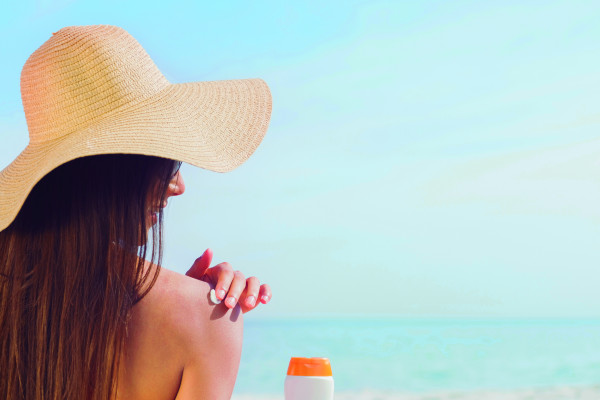Standards and sun protection – we have you covered
Since the early 1980’s good Kiwis have known to slip, slop, slap and wrap when exposed to New Zealand’s harsh summer sun. But did you know standards sit behind the effectiveness of the products you use for protection?

Being sun smart with a wide brimmed hat and sunscreen. By Skeyndor.oficial/CC0 1.0.
Being sun smart is about protecting your skin and your eyes from the sun’s damaging ultraviolet (UV) rays. For decades Te Hiringa Hauora, the Health Promotion Agency, and Cancer Society New Zealand have encouraged positive action to protect, rather than seeking to soak up the sun’s rays via the slip, slop, slap and wrap campaign. Australia and New Zealand have the world’s highest incidence of melanoma and melanoma is the third most common cancer diagnosed in Australia.
Hannah Booth, Advocacy Manager: THH SunSmart with Cancer Society of New Zealand says: Be SunSmart when the ultraviolet index (UVI) is 3 or above. Slip into shade or slip on clothing that covers most of your skin. Slop on plenty of sunscreen, at least SPF 30, 20 minutes before heading out and reapply every 2 hours. An average-sized adult needs seven teaspoons of sunscreen for their whole body. Children need a little less. Choose a sunscreen that meets the Australian and New Zealand standard AS/NZS2604. Slap on a wide-brimmed hat and wrap on close fitting, wrap-around style, sunglasses that meet the Australian and New Zealand standard AS/NZS 1067.
Slip on a tee
Clothing acts as the one of the most effective barriers and fabrics with a tighter weave and darker colours offering better protection. Sun protective fabrics should be tested in an accredited lab, on every bulk colour, every summer season against AS/NZS 4399:2017 Sun protective clothing - Evaluation and classification. It’s mandatory to provide a UPF rating if manufacturers make a sun protection claim, and there are also design requirements that must be followed.
Slop on sunscreen
In 2021 the preceding 2012 version of AS/NZS 2604:2021 Sunscreen Products - Evaluation & Classification was cited in the Sunscreen (Product Safety Standard) Act 2022 to make sure that sunscreen did what it said on the packaging and underwent robust testing.
Australian and New Zealand sunscreens may display the AS/NZS 2604, however other international products may test against similar standards such as ISO 16217:2020 Cosmetics – Sun protection test methods – Water immersion procedure for determining water resistance and ISO 24444:2019 which determines the sun protection factor (SPF) based on living organisms.
Standards also help with clarifying labelling, for example not permitting misleading words like ‘waterproof’, ‘sunblock’ or ‘sweat proof’.
Slap on a hat
Broad brimmed, legionnaire-style and bucket hats are commonplace across New Zealand and Australia for good reason – they offer some of the best protection. But similarly to clothing, good protection goes beyond the style of hat, with the type of fabric and testing against NZ Standard AS/NZS 4399:1999 or later versions offering greater assurance.
Wrap on sunglasses
It’s easy to forget the impact sun can have on the health of your eyes and sunglasses are not just fashion accessories. Good quality sunglasses should offer UV protection so they serve a health benefit beyond looking like you’re fresh from the Matrix. To guarantee this protection standards exist to determine the test methods and requirements that need to be met:
AS/NZS 1067.1:2016 Eye and face protection - Sunglasses and fashion spectacles - Part 1: Requirements and AS/NZS 1067.2:2016 Part 2: Test methods
ISO 12312-1:2022 Eye and face protection — Sunglasses and related eyewear — Part 1: Sunglasses for general use and ISO 12312-2:2015 Part 2: Filters for direct observation of the sun and ISO 12312-3:2022 Part 3: Sunglasses for running, cycling and similar active lifestyles.
Seek shade
The slip, slop, slap campaign in Australia adds a further step to ‘seek’ out shade. While there are many standards that support good quality buildings for shelter, there’s no specified standard for shade. Regarding all the other precautions you can take against those UV rays, standards have you covered, quite literally.
Stay healthy and safe this summer.
